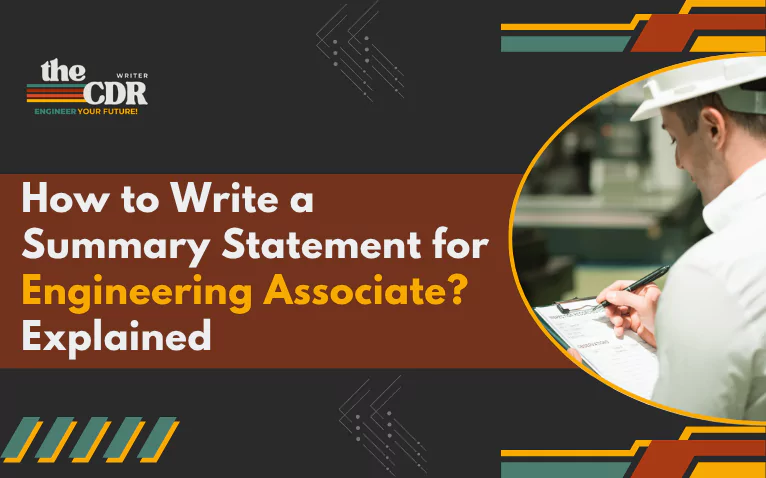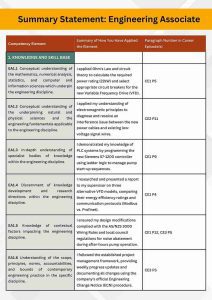The Summary Statement is arguably the most critical component of your Competency Demonstration Report (CDR) for an Engineering Associate. It is the first document the Engineers Australia assessor will read, acting as a roadmap to your skills and a crucial first impression. It bridges the gap between your detailed Career Episodes and the specific Stage 1 Competency Standards you need to prove.
But how do you effectively condense complex projects into this specific format? In this comprehensive guide, we will break down exactly how to write a Summary Statement for Engineering Associate. We’ll cover its purpose, the required format, and the common mistakes to avoid, ensuring you present your qualifications with clarity and confidence.
Table of Contents
ToggleWhat Is a Summary Statement for an Engineering Associate?
A Summary Statement for an Engineering Associate is a critical, one-page document that forms part of the Competency Demonstration Report (CDR) submitted to Engineers Australia for a skills assessment.
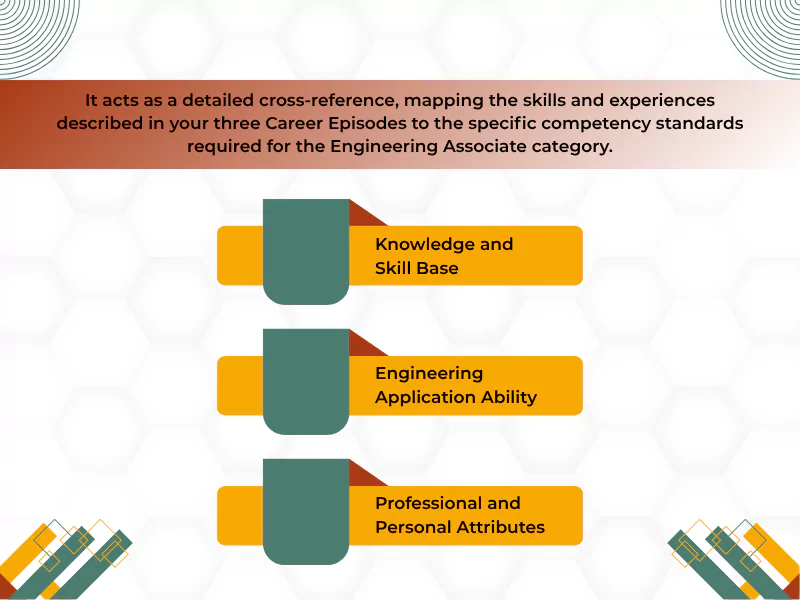
Think of it as the master index to your entire CDR. It is the first document an assessor reviews, and its primary purpose is to make their job easier by providing a clear and immediate overview of your qualifications.
Instead of searching through your entire report, the assessor can use the Summary Statement to quickly locate the exact paragraphs in your Career Episodes where you have demonstrated a specific required competency.
Why Is the Summary Statement Important for Engineers Australia Skill Assessment?
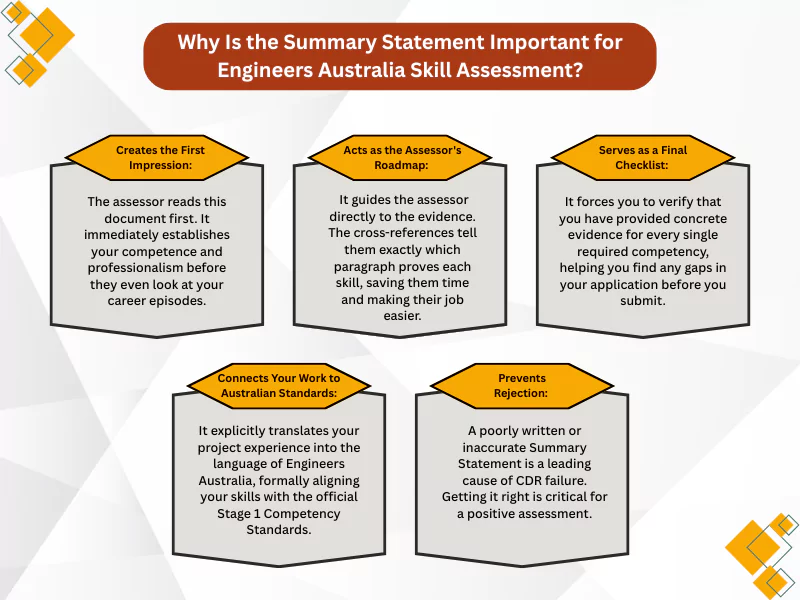
It's the Assessor's First Point of Analysis:
The EA assessor reads the Summary Statement first. This document provides the first impression of your engineering capabilities and professionalism. A clear, well-structured Summary Statement immediately signals a competent and organized applicant, while a confusing one can weaken an otherwise strong application from the start.
Acts as a Roadmap for the Assessor:
Think of the Summary Statement as a map for the assessor. The CDR Report is a lengthy document, and the assessor’s job is to verify that you meet each of the 16 competency elements. The Summary Statement makes this process efficient by providing direct cross-references to the exact paragraphs in your Career Episodes where you have demonstrated a particular skill. This prevents the assessor from having to hunt for the evidence themselves.
Provides a Clear Competency Checklist:
The document is structured as a table that lists every required competency element. This format forces you to consciously analyse your Career Episodes and ensure you have provided sufficient evidence for each standard. If you find it difficult to pinpoint a paragraph for a specific competency, it’s a clear sign that you may need to revise your Career Episodes.
Connects Your Experience to Australian Standards:
The primary goal of the CDR is to prove that your skills and knowledge are equivalent to those of an Australian-educated Engineering Associate. The Summary Statement is where this connection is made explicit. It systematically aligns your personal project experiences with the official Stage 1 Competency Standards, leaving no doubt about your qualifications.
A Major Factor in Preventing Rejection:
A significant number of CDR rejections are due to a poorly written Summary Statement. If any competency is missed, not properly evidenced, or if the cross-references are incorrect, your skills cannot be validated, which can lead to a negative assessment.
How to Write a Summary Statement for Engineering Associates?
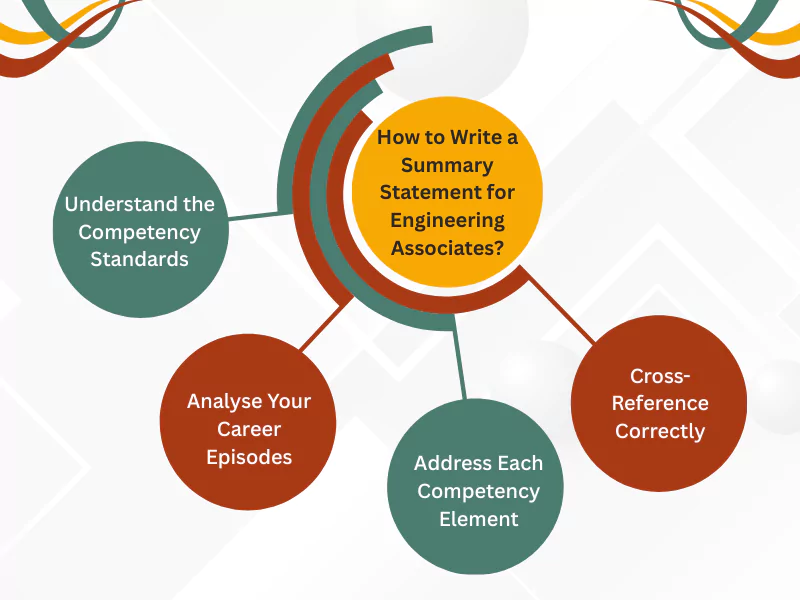
Writing a powerful Summary Statement is a methodical process. It requires you to act like an auditor of your own work, carefully connecting your experience to a formal set of standards. This step-by-step guide will walk you through the process, ensuring you create a clear, convincing, and effective document for your Engineers Australia skills assessment.
1. Understand the Competency Standards
Before you can write the Summary Statement, you must first understand the criteria you are being assessed against. For an Engineering Associate, these are the Stage 1 Competency Standards. You cannot effectively demonstrate these competencies if you don’t know what they are.
Action Step: Download the official Summary Statement template for the Engineering Associate category from the Engineers Australia website. This template lists every competency element you must address.
The Three Core Categories: The competencies are divided into three main groups:
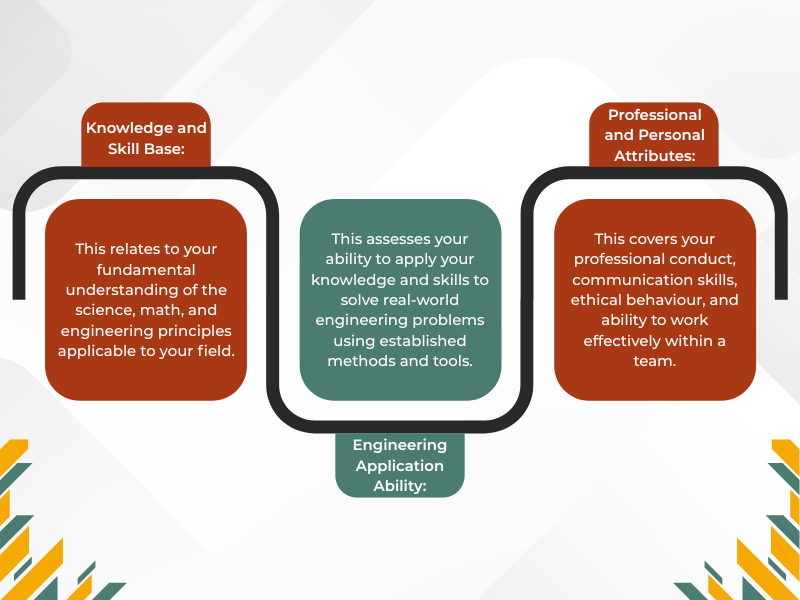
Familiarise yourself with the specific meaning of each of the 16 elements within these categories.
2. Analyse Your Career Episodes
Your Career Episodes are the evidence. The Summary Statement is the argument that presents the evidence. You need to thoroughly comb through your three Career Episodes to find the specific examples that prove each competency.
- Action Step 1: Number Every Paragraph. Before you begin, ensure every paragraph in your three Career Episodes is numbered. A common format is CE1-P1, CE1-P2 (for Career Episode 1, Paragraph 1, 2), and so on. This is crucial for cross-referencing.
- Action Step 2: Read with a Purpose. Read through each Career Episode with the list of competency elements in front of you. As you read, highlight sentences or paragraphs where you demonstrate a specific skill. For example, when you read a paragraph describing how you diagnosed a fault in a system, you can mark that as potential evidence for “EA2.1 Application of established engineering methods.”
- Action Step 3: Map Your Evidence. Create a rough draft or a spreadsheet. For each of the 16 competency elements, jot down the paragraph numbers from your Career Episodes that contain the strongest proof. Remember, you must demonstrate all 16 competencies at least once across your three episodes.
3. Address Each Competency Element
Now you will fill out the Summary Statement template itself. For each competency element, you need to write a brief, one- or two-sentence summary of how you have applied that skill.
Be Direct and Specific: This is not the place for storytelling. Your summary should be a concise statement that directly reflects the competency.
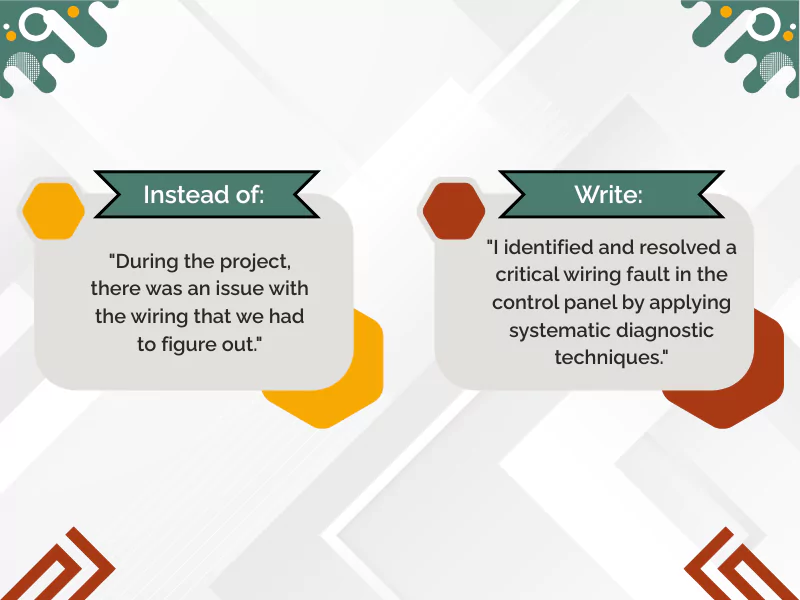
Use the First Person: Always write in the first person (“I did,” “I calculated,” “I designed”) to emphasize your personal contributions.[9] Avoid using “we” or “the team.”
Focus on Your Actions: Your summary should highlight your specific actions and decisions.
- For “EA3.2 Effective communication”: “I prepared and delivered weekly progress reports to the project manager and communicated technical requirements to the installation team.”
- For “EA2.2 Application of engineering technology”: “I utilized AutoCAD to develop detailed schematics and selected appropriate components based on the project’s technical specifications.”
4. Cross-Reference Correctly
This is the final, crucial step that ties everything together. In the third column of the template, you must list the exact paragraph numbers from your Career Episodes where the assessor can find the evidence for your claim.
- Be Accurate: Double-check that the paragraph numbers you list truly correspond to the competency you are claiming. An incorrect reference can frustrate an assessor and weaken your credibility.
- Cite All Relevant Paragraphs: If you have demonstrated a single competency in multiple instances across different Career Episodes, be sure to list all the relevant paragraph numbers. For example, CE1-P4, CE2-P7, CE3-P5.
- Ensure Clarity: The purpose of the cross-reference is to make the assessor’s job easy. They should be able to flip directly to the paragraph you cited and immediately see the proof of your skill.
By following this structured approach—understanding the standards, analysing your evidence, writing concise summaries, and referencing accurately—you will create a professional and convincing Summary Statement that clearly demonstrates your qualifications as an Engineering Associate.
Is There a Specific Format or Template for Engineering Associate Summary Statements?
Yes, absolutely. Engineers Australia (EA) provides an official and mandatory template that all applicants for the Engineering Associate category must use. It is not optional, and you should not create your own format.
Using the official template is critical because it ensures that your application directly aligns with the assessment criteria. The template is structured as a table with three columns:
1. Competency Element:
This column lists the specific competency standard you need to demonstrate, with its unique code (e.g., EA1.1, EA2.3).
2. Summary of How You Have Applied the Element:
In this column, you must write a brief, one- or two-sentence summary describing how your work experience, as detailed in your Career Episodes, proves you have met this competency.
3. Paragraph Number in Career Episode(s):
Here, you must provide the exact paragraph number(s) from your three Career Episodes that support your claim in the second column. For example, CE1 P4-P6 or CE2 P11, CE3 P8.
You can download this official template directly from the Engineers Australia website. Always ensure you have the most current version before you begin writing.
How Do the Competency Elements Relate to the Engineers Australia Stage 1 Requirements?
The competency elements are the Stage 1 requirements for an Engineering Associate. The terms are often used interchangeably. The “Stage 1 Competency Standards” is the formal name for the set of skills and attributes an individual must demonstrate to be recognised as a qualified Engineering Associate in Australia.
These standards are broken down into a hierarchy to provide a clear framework for your application:
- Three Main Competency Categories: These are the high-level groups that organise your skills:
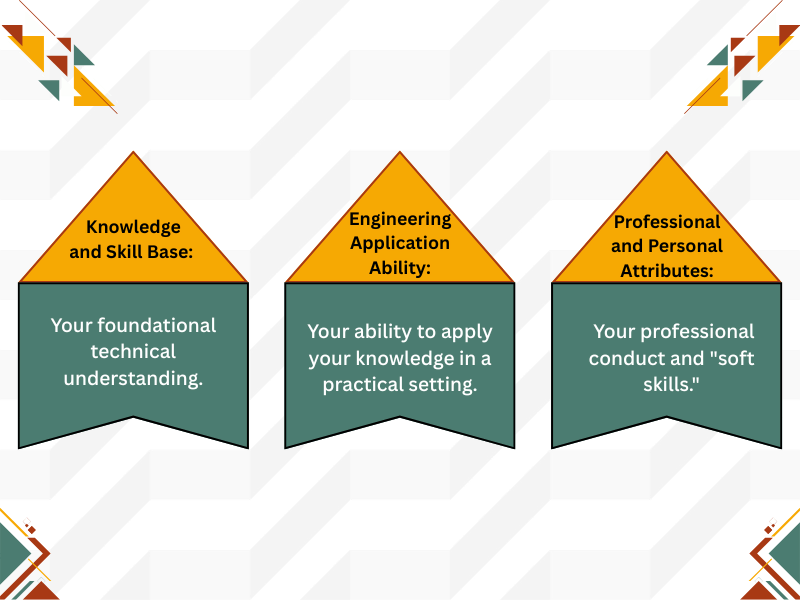
- 16 Competency Elements: Within these three categories, there are 16 specific elements. Each element describes a particular skill or attribute you must prove. For example, under “Engineering Application Ability,” you will find elements like EA2.1: Application of established engineering methods and EA2.2: Application of engineering technology.
Your Summary Statement serves as the final proof that you have met all 16 of these elements. Each row in the Summary Statement template corresponds directly to one of these Stage 1 competency elements. Therefore, successfully completing your Summary Statement is equivalent to demonstrating that you have fulfilled the Stage 1 requirements for an Engineering Associate.
What Mistakes Should I Avoid While Writing a Summary Statement for an Engineering Associate?
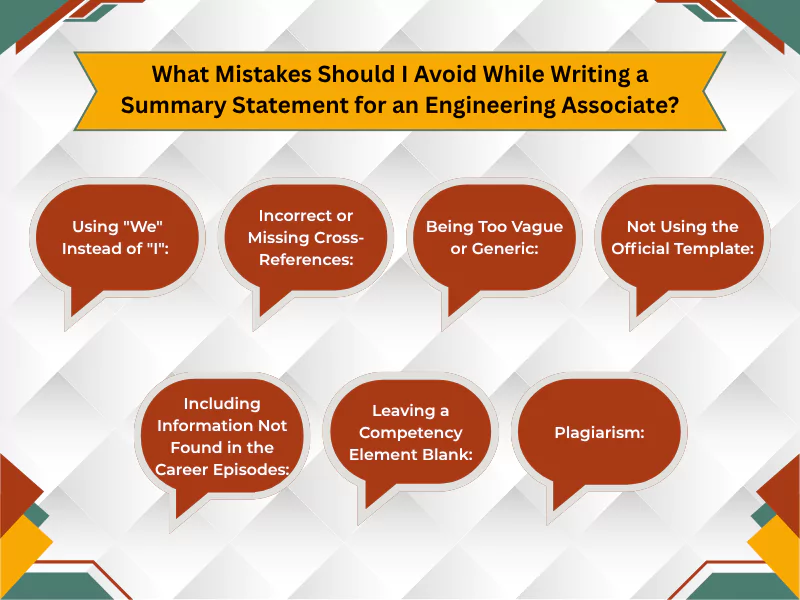
This is a crucial question, as avoiding common errors can be the difference between a successful assessment and a request for more information or even a rejection. Here are the most critical mistakes to avoid:
1. Using “We” Instead of “I”: This is the most common mistake. The assessor needs to evaluate your personal skills, not the achievements of your team. Always write in the first person (e.g., “I designed,” “I calculated,” “I communicated”).
2. Incorrect or Missing Cross-References: The link between your claim and your evidence must be perfect. A wrong paragraph number frustrates the assessor and undermines your credibility. Double-check every single reference.
3. Being Too Vague or Generic: Avoid simply rephrasing the competency element. Provide a specific, concrete example of what you did.
- Weak: “I used effective communication.”
- Strong: “I prepared weekly progress reports for the project manager and led daily toolbox talks with the site crew to ensure safety compliance.”
4. Not Using the Official Template: Creating your own format or significantly altering the official one will likely lead to a negative assessment. Stick to the provided structure.
5. Including Information Not Found in the Career Episodes: The Summary Statement is for summarising and referencing existing evidence. Do not introduce new skills or examples that are not already detailed in your three Career Episodes.
6. Leaving a Competency Element Blank: You must address every single competency element. If you find you have no example for a particular element, you need to revise your Career Episodes to include one.
7. Plagiarism: Copying a Summary Statement from an online sample is a serious offence that can result in a ban from Engineers Australia. Your statement must be a true and original reflection of your own work because plagiarism is not allowed in CDR.
By carefully avoiding these pitfalls, you can ensure your Summary Statement is a powerful and effective tool that accurately showcases your qualifications as an Engineering Associate.
As this guide shows, writing a perfect Summary Statement requires meticulous attention to detail and a deep understanding of Engineers Australia’s standards. Your future engineering career in Australia depends on getting this skills assessment right the first time.
Why leave it to chance?
At TheCDRWriter.com, our sole focus is helping engineers like you prepare flawless Competency Demonstration Reports, offering professional summary statement writing services. Our team of experts knows exactly what assessors are looking for and can ensure your Summary Statement is powerful, precise, and perfectly aligned with EA’s requirements.
Our professional services will help you:
- Avoid common mistakes that lead to rejection.
- Save dozens of hours of stressful work.
- Maximise your chances of a positive skills assessment.
Take the next step with confidence. Contact us today for a free review and consultation.
Frequently Asked Questions
Can I Use a CDR Sample to Help Write My Summary Statement?
You can use an engineering associate CDR sample as a reference for formatting and structure when writing your summary statement. However, avoid copying content directly. Use it as a guideline and resource to understand the indicators, but tailor your work to your unique experience to comply with Engineers Australia migration skills assessment requirements.
Do I Need to Tailor My Summary Statement for Each Career Episode?
Yes. For an engineering associate ANZSCO 312312, tailor your summary statement for each engineering career episode. Link specific elements and indicators of the competency standards to activities described in your episodes. This ensures each statement reflects your occupational skills, matching Engineers Australia’s guidelines for your migration skills assessment.
How Do I Link My Career Episodes to the Summary Statement Effectively?
Map each paragraph of your engineering career episode summary to relevant competency elements in your summary statement. Number paragraphs (e.g., CE1.1, CE1.2) and refer to these in your summary to clearly demonstrate individual engineering associate competencies in line with the Engineers Australia guidelines and summary statement writing tips.
What Are the Key Elements to Include in a Summary Statement for ANZSCO 312312?
Include all required competency elements and indicators, such as engineering knowledge, problem-solving, teamwork, communication, and application of standards. Address each indicator for your occupational category and provide evidence from your career episodes, following the summary statement Engineers Australia guidelines for engineering competency report writing.
Want To See My Profile — Click Here Iqbal

